I wrote some time ago about zoological treasures in archeological, ethnological and historical museums. Today I want to share some quite interesting examples of such „treasures“ which I have seen in the Oceania exhibition of the Ethnological Museum of Berlin. What you see here is a boar’s mandible from Vanuatu, a group of islands located in the South Pacific Ocean east of Australia.

The obviously most striking feature of the mandible are the extremely long circular tusks. They are so long that their tips have grown into the lower jaw and penetrated the bone.

You can see how how the infection caused by the tusk tips lead to a degradation of the surrounding bone and a thickening of the bone behind. The ingrown tusks acts like foreign bodies and cause a constant local infection. In the living animal they must have pierced the cheeks as well.

This is an extracted lower boar tusk, which shows how the tooth formed a full circle, with the tip just next to its own apical end.

Here is another example, but this boar luckily died before the tusks could impale its jaw.

For a considerable time I was wondering how this circle tusks could grow to such grotesque shapes. It was obvious that it resulted from a lack of abrasion with the upper tusk, which usually limit the lengths of the lower tusks while forming constantly sharp edges. Sometimes we see similar cases as a result of misplaced teeth which lead to a missing abrasion between upper and lower tusks. I covered such a case of a pot-bellied pig which had highly elongated lower tusks. The extremely shortened skull and jaws of pot-bellied pigs often result into various tooth displacements. But those jaws from Vanuatu belonged to pigs which were still quite primitive compared with most modern breeds, with long heads similar to wild boars and with well grown teeth.
So how could they grow this bizarre circle tusks? Were those pigs possibly selected for dental misplacement that make such teeth growing“naturally“? The answer is no, those boars were actually results of a surgical procedure which made their tusks growing into this unnatural shapes. Their upper tusks were extracted at early age, so the natural curve of the lower tusks could grow longer and longer without being abraded by an antagonistic upper tusk. The boars selected for this were kept isolated and fed with special food, and apparently they were also castrated. This was likely to avoid accidental fractures of the tusks during fights with other boars and to let them grow better even with the chronic inflammation of the cheeks and jawbone.
But why did Vanuatuans want boars with circle tusks? The answer is pretty simple, because breeding boars with circle tusks was literally like breeding money. Those circle tusks were not just used for decoration or jewelry but as money as well. And they longer they were, the bigger their worth was. They were used to make jewelry like necklaces, as decoration for sculptures and for certain rituals. You have to keep in mind that it takes several years until a boar has grown a circle tusk, and even more for a spiral tusk. During this whole time it needs extra food, and even more than a normal pig, which can also forage in the wild. But when the boar is finally killed and its tusks removed, they are worth a little fortune. I highly recommend to watch this short documentary about the role of circle tusks in modern Vanuatu. You can also see a living boar with circle tusks which pierce its cheeks. There are also a few incredibly extreme spiraling tusks from an ethnological collection featured as well.
You can get an idea about the importance of circle boar tusks if you take a look at the flag and the coat of arms of Vanuatu.

The whole museum exhibition at Berlin was moved to another location after my last visit and I don’t know if those specimens will be still exhibited in the new museum. It was the same exhibition which also included the mislabeled Kogia mandible about which I already wrote.
This is mainly an updated version of a blog post which I already wrote in 2009 in German. You can find the original post here.

You are the only blog with the most detailed content on this topics. I appreciate it.
I collect ’skulls with overgrown tusks‘ made by different approaches around the world, and I found it fascinating that the most domestic pigs can achieve the condition of circular tusks, but it’s rare on the wild boar if you removed their upper tusks at young age. I don’t know why.
I could imagine that wild or feral pigs have perhaps also a higher risks of breakage before the tusks can grow into circles. I have however found some images of wild specimens online which show mandible-piercing circle tusks from boars which lived in the wild as well.
I love and want this kind of boars tusk, how can I get or buy this?
I have a contact who trades them from Vanuatua, but admittedly they are rather expensive.